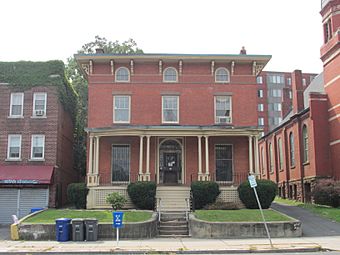Hyde-St. John House facts for kids
Quick facts for kids |
|
|
Hyde-St. John House
|
|
 |
|
| Location | 25 Charter Oak Ave., Hartford, Connecticut |
|---|---|
| Area | less than one acre |
| Built | 1858 |
| Architectural style | Italianate |
| NRHP reference No. | 77001422 |
| Added to NRHP | October 6, 1977 |
The Hyde-St. John House is a special old building in Hartford, Connecticut. It was built way back in 1858. This house is a great example of a building style called Italianate architecture. It's one of the best-preserved houses of its kind in the city. A very important person, William Waldo Hyde, who was once the mayor of Hartford, lived here. The house was added to the National Register of Historic Places in 1977. Today, it is used for businesses.
What is the Hyde-St. John House?
The Hyde-St. John House is in a neighborhood of Hartford called Sheldon-Charter Oak. You can find it on Charter Oak Avenue. It's located between the old Temple Beth Israel building and where the famous Charter Oak tree used to stand.
A Look at the House's Style
This house is made of brick and has three floors. It's mostly square-shaped. The roof is flat, but it has a cool part that sticks out, called an eave. This eave is held up by decorative brackets.
The windows on the first two floors are rectangular. They have stone sills and tops. The windows on the third floor are a bit shorter and have rounded tops. There's a porch at the front of the house. It has rounded parts on the sides and columns that look like they're grouped together.
The main front door is fancy. It has tall, flat columns on each side. There are also narrow windows next to the door. Above the door, there's a beautiful rounded window with a fan-like design. You can even see carved wooden oak leaves above this window. Inside, many of the original wooden details and plaster are still there. At the back of the house, there's a two-story addition that was built around the same time as the main house.
Who Lived Here? The Story of William Waldo Hyde
The Hyde-St. John House was built in 1858. From 1881 to 1896, it was the home of William Waldo Hyde. His family was very well-known in the area. William Waldo Hyde was a leading lawyer in one of Hartford's oldest law firms.
He was also very important in local government. From 1892 to 1894, he served as the Mayor of Hartford. This means he was the main leader of the city. The Hyde family and another family, the Waldos, owned other houses nearby. This created a small group of family homes. In the 1970s, the house was carefully fixed up. Now, different businesses use the building.



